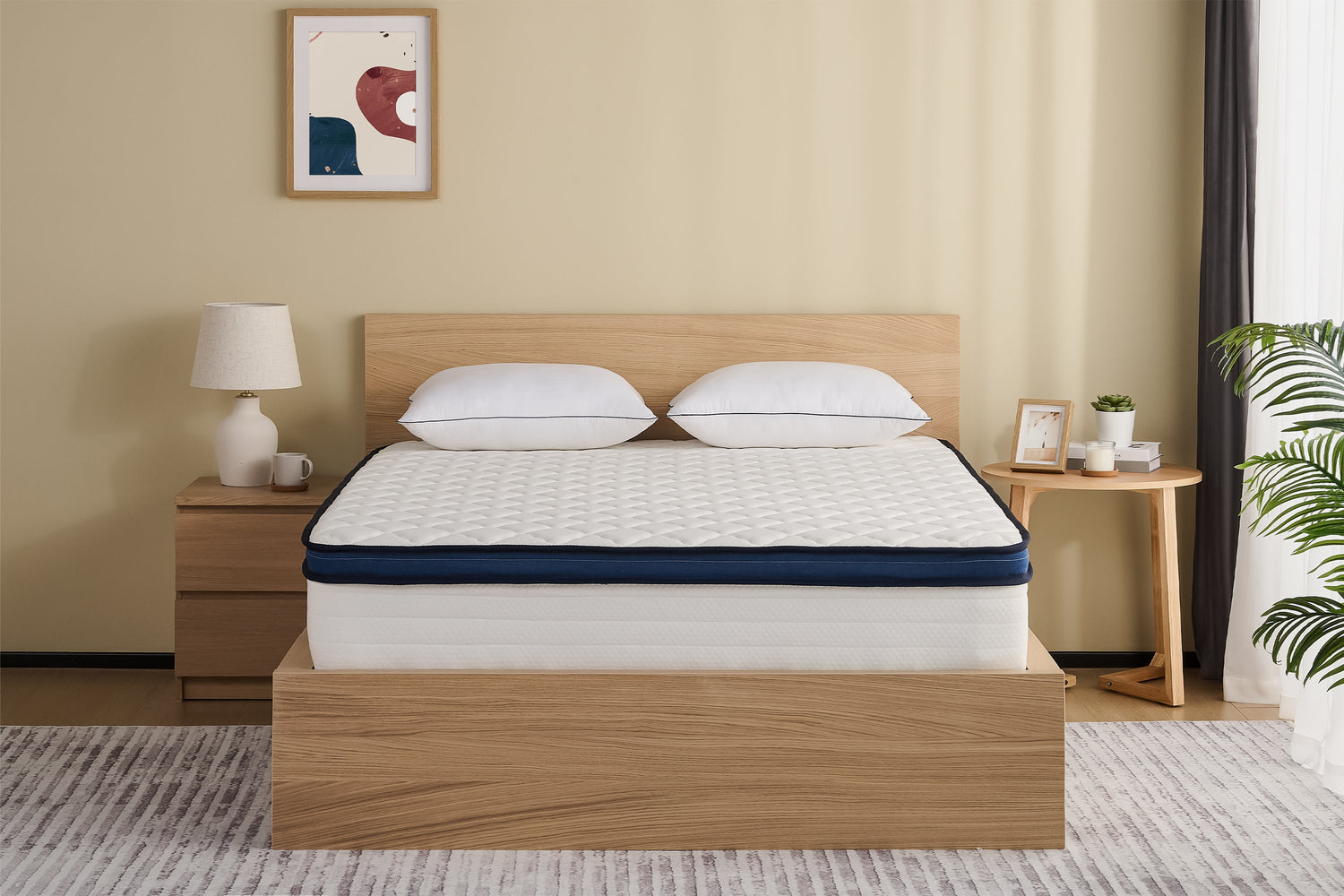There are many types of mattress materials, each with unique advantages and applications. Here’s an overview of the main options:
- Innerspring
- Memory foam
- Gel memory foam
- Polyfoam
- Latex
- Hybrid
- Air bed
- Water bed
What is a innerspring mattress?

Innerspring mattresses are considered the "classic" option. Their history dates back to the late 19th century. Innerspring mattresses offer excellent support and durability and have grown in popularity over the years. Early Bonnell springs were one-piece and interconnected, providing good support but with issues like significant motion transfer and noise under pressure, which can be disruptive for couples.
However, the development of individually pocketed coils has addressed these issues. Each coil can move independently, reducing motion transfer and noise, making these mattresses quieter and more adaptable to body curves.
What are the pros and cons of innerspring mattresses?
Pros:
- Strong support: Innerspring mattresses provide firm support and are especially suitable for those needing extra back support.
- Good ventilation: They have gaps that allow air circulation, keeping the mattress dry and cool—ideal for people who get hot while sleeping.
- Great value: Generally more affordable than memory foam, making them a good option for budget-conscious consumers.
- Durability: High-quality innerspring mattresses can last many years.
Cons:
- Motion transfer: One-piece innerspring mattresses can have more motion transfer between partners, potentially affecting sleep quality.
- Possible noise: Over time, they may produce noise due to wear and tear on the springs.
- Limited edge support: Some models may lack strong edge support, causing the edges to sag.
What is a memory foam mattress?

Memory foam, originally developed for airplane seats in the 1960s, is known for its slow rebound properties, which allow it to absorb impact. It’s popular for its comfort and motion isolation but is not water-resistant. It’s best to use a waterproof mattress protector with memory foam.
What are the pros and cons of memory foam mattresses?
Pros:
- Pressure relief: Memory foam evenly distributes body weight and relieves pressure points, contouring to the body's curves and offering a cloud-like feel—especially beneficial for joint issues.
- Motion isolation: It reduces motion transfer, making it ideal for couples who want a quieter sleeping environment.
Cons:
- Heat retention: Traditional memory foam can retain heat, leading to a warmer sleeping experience.
- Slow rebound: The foam’s slow rebound can make turning over feel sluggish.
- Odor: New memory foam mattresses may emit a slight chemical smell that needs time to dissipate.
What is a gel memory foam mattress?

Gel memory foam is an advanced version of memory foam designed to address heat retention issues. It incorporates gel particles or layers to improve breathability and temperature regulation but is often more expensive.
What are the pros and cons of gel memory foam mattresses?
Pros:
- Temperature regulation: Gel particles help absorb and disperse body heat, offering a cooler sleep experience.
- Pressure relief: It evenly distributes body weight and alleviates pressure points.
- Motion isolation: It effectively reduces motion transfer, making it suitable for couples.
Cons:
- Increased weight: The addition of gel may make the mattress heavier and harder to move.
- Possible unevenness: Low-quality gel memory foam may have uneven gel distribution, leading to uneven support.
- Higher price: It is generally more expensive than traditional memory foam.
What is a foam mattress?

Foam mattresses, often made from polyurethane, are versatile and affordable. They come in various densities and hardnesses, which can be customized to different needs.
What are the pros and cons of foam mattresses?
Pros:
- Variety: Foam mattresses offer various density and firmness options to meet different comfort needs.
- Affordable: Generally less expensive than other types, making them a good budget option.
- Lightweight: Easier to move due to their lighter weight.
Cons:
- Less breathable: Foam mattresses are less breathable compared to latex or hybrid options, potentially leading to overheating.
- Limited support: Low-density foam may lack adequate support and have a shorter lifespan.
- Easily warped: Low-quality foam can dent and warp with heavy use.
What is a latex mattress?

Latex, derived from the sap of the rubber tree, is known for its comfort, elasticity, and natural antibacterial properties. It comes in natural and synthetic forms. Natural latex offers better breathability and elasticity, while synthetic latex is more durable and affordable.
What are the pros and cons of latex mattresses?
Pros:
- High elasticity: Offers excellent elasticity, strong support, and comfort, suitable for various sleeping positions.
- Natural antibacterial and anti-mite: Resists bacteria and dust mites, making it suitable for allergy sufferers.
- Good breathability: The open cell structure helps keep the mattress cool and dry.
Cons:
- Higher price: Natural latex mattresses can be expensive.
- Heavier: Generally heavy and challenging to move.
- Possible odor: Some latex mattresses may have a slight rubbery smell when new, which dissipates over time.
After reviewing the pros and cons of different materials, you might wonder if there’s a perfect mattress. The answer is yes! Hybrid Mattresses combine the benefits of multiple materials. Typically, they consist of a spring support system (such as individually pocketed springs) and comfort layers (like memory foam, gel memory foam, or latex).

What are the pros and cons of hybrid mattresses?
Pros:
- Good support and comfort: Combines springs and foam for excellent support and comfort. The spring system supports the body, while foam or latex layers relieve pressure and improve spinal alignment.
- Motion isolation: Individually wrapped coils allow each spring to move independently, reducing motion transfer and minimizing sleep disturbances.
- Suitable for various sleeping positions: Adapts well to different sleeping positions, offering the right support and comfort whether you sleep on your side, back, or stomach.
- Better air circulation: The spring system promotes airflow, helping to regulate temperature and keep the mattress cool, which is beneficial for those who sweat during sleep.
- Variety of options: Offers many material and layer combinations to suit different preferences and needs.
Mattress materials to avoid: Fiberglass
Fiberglass, made from tiny glass strands, is used in some mattress interlayers. If not properly sealed, fiberglass can leak through the fabric, causing irritation, itching, and rashes. Inhalation can irritate the respiratory tract, leading to symptoms like sore throat, cough, and shortness of breath. It’s also a carcinogen. To avoid this, look for mattresses with CertiPUR-US certification to ensure material safety.
How to choose the right mattress type? Consider the following:
- Comfort: Choose a mattress that aligns with your sleep habits and preferences to ensure comfort and relaxation in any position.
- Support: Select a mattress that supports natural spinal alignment based on your physical condition. For back pain, consider hybrid or latex options.
- Durability: Opt for reliable materials and brands to ensure longevity and consistent performance.
- Heat dissipation: For better temperature control, choose a mattress with good breathability, such as latex, hybrid, or memory foam with cooling gel.
- Motion isolation: If sharing a bed, consider mattresses with good motion isolation, like hybrids with memory foam or gel memory foam, to minimize disturbances.
- Budget: Balance your needs with your budget. High-quality mattresses can be costly, but many affordable options offer good value.

We spend about a third of our lives in bed, so selecting the right mattress is crucial for ensuring good sleep and overall health.
Good night!






